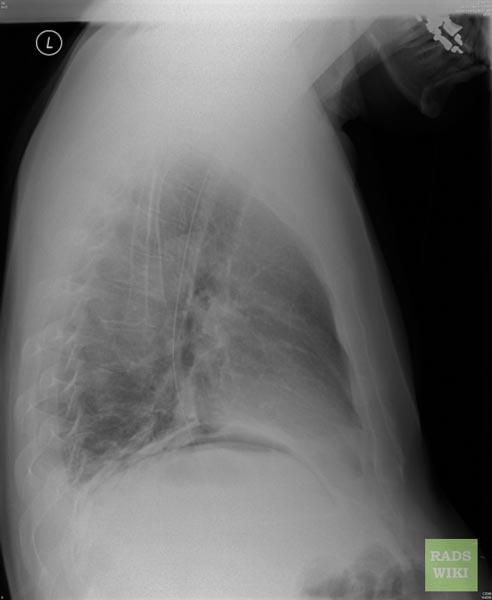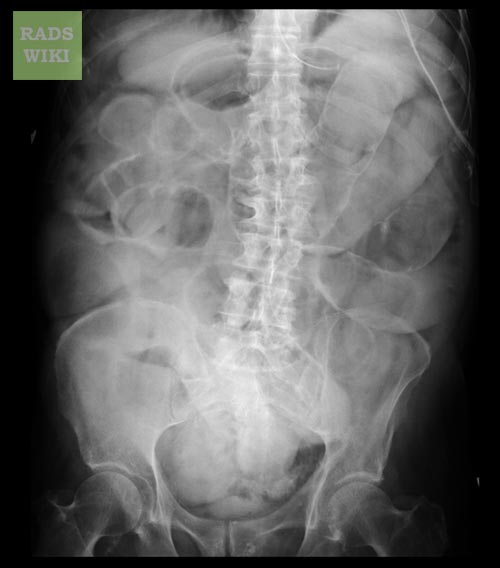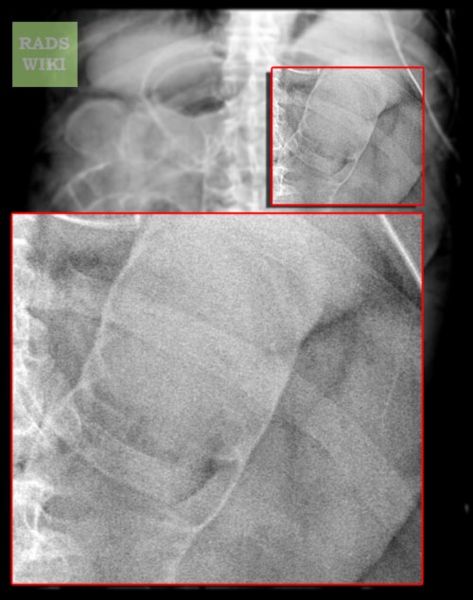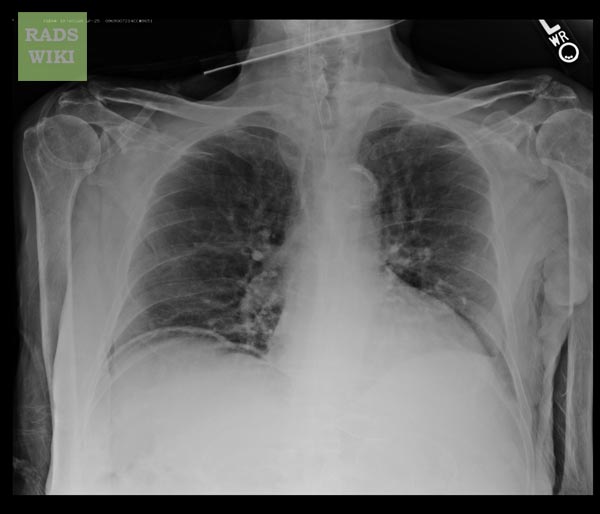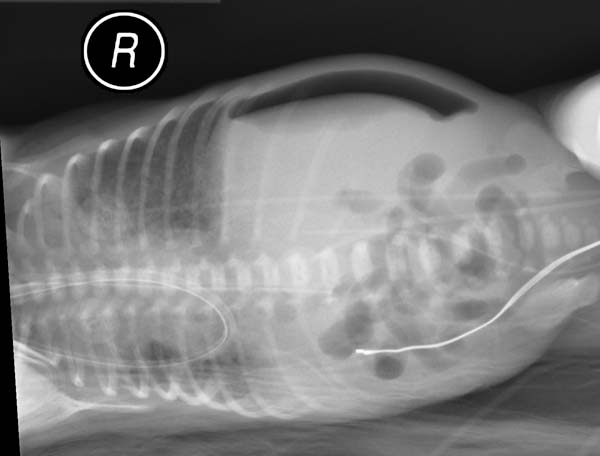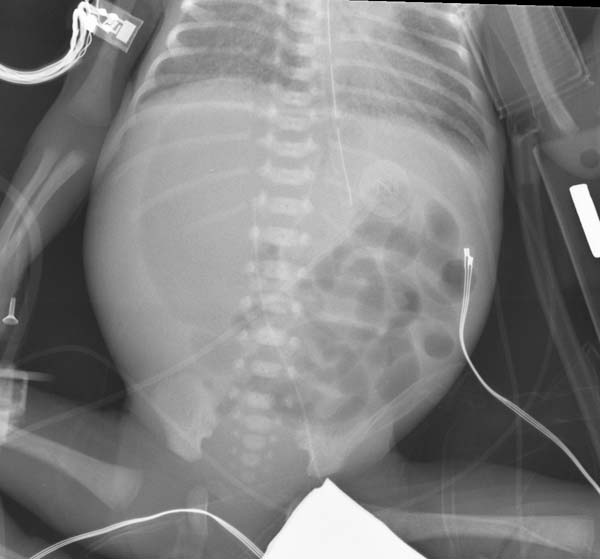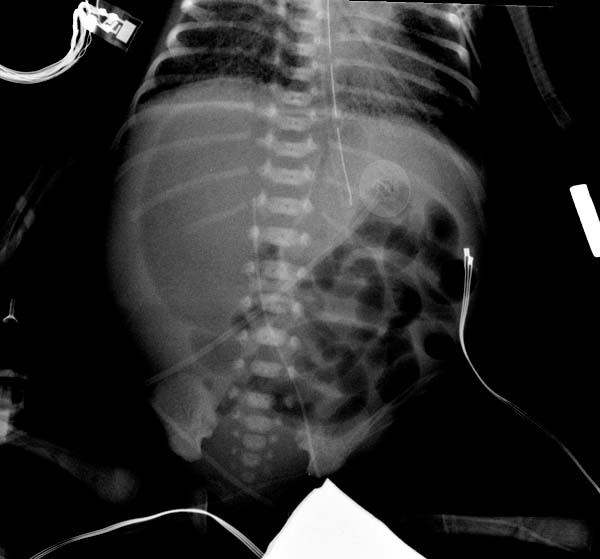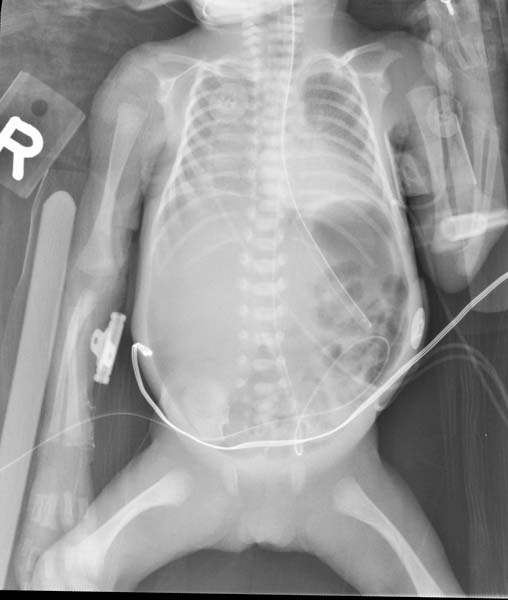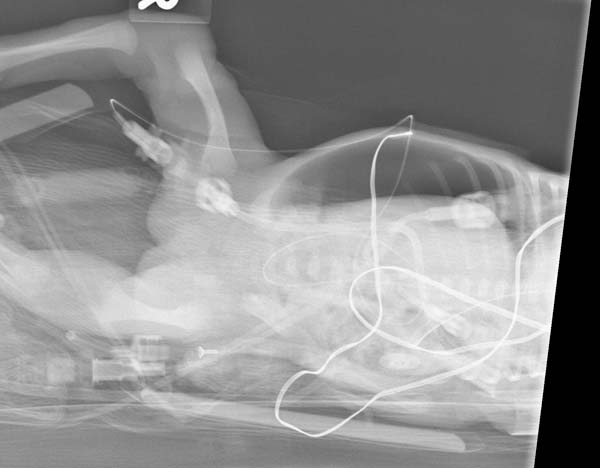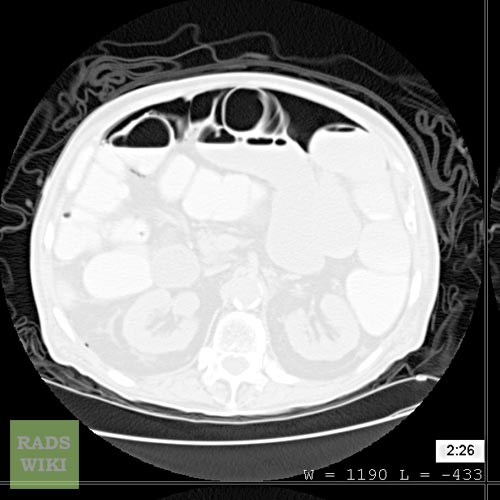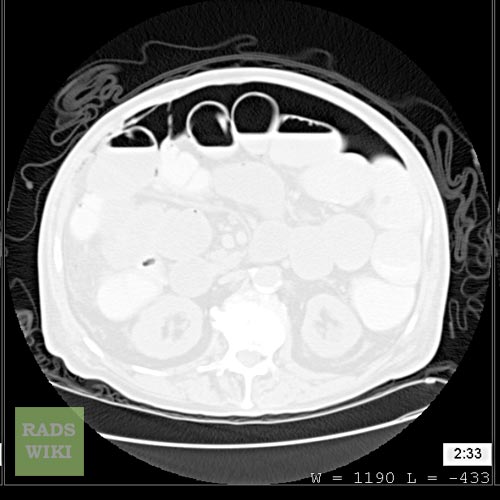Pneumoperitoneum: Difference between revisions
No edit summary |
Kiran Singh (talk | contribs) |
||
| (12 intermediate revisions by 3 users not shown) | |||
| Line 18: | Line 18: | ||
==Overview== | ==Overview== | ||
'''Pneumoperitoneum''' is air or gas in the abdominal (peritoneal) cavity<ref>{{cite web | url = http://www.kmle.com/search.php?Search=pneumoperitoneum | title = ''KMLE American Heritage Medical Dictionary definition of pneumoperitoneum'' | author = [http://www.kmle.com The American Heritage Stedman's Medical Dictionary]}}</ref>, often seen on [[x-ray]], but small amounts are often missed and [[CT]] is nowadays regarded as a criterion standard in the assessment of a pneumoperitoneum.<ref>{{cite web | url = http://www.emedicine.com/radio/topic562.htm | title = eMedicine.com: Pneumoperitoneum'' | author = Ali Nawaz Khan}}</ref> | '''Pneumoperitoneum''' is air or gas in the abdominal (peritoneal) cavity<ref>{{cite web | url = http://www.kmle.com/search.php?Search=pneumoperitoneum | title = ''KMLE American Heritage Medical Dictionary definition of pneumoperitoneum'' | author = [http://www.kmle.com The American Heritage Stedman's Medical Dictionary]}}</ref>, often seen on [[x-ray]], but small amounts are often missed and [[CT]] is nowadays regarded as a criterion standard in the assessment of a pneumoperitoneum.<ref>{{cite web | url = http://www.emedicine.com/radio/topic562.htm | title = eMedicine.com: Pneumoperitoneum'' | author = Ali Nawaz Khan}}</ref>. | ||
A pneumoperitoneum is deliberately created by the surgical team in order to perform [[laparoscopic surgery]]. This is achieved by insufflating the abdomen with [[carbon dioxide]]. | ==Causes== | ||
The most common cause is a perforated abdominal viscus, generally a perforated [[ulcer]], although any part of the [[bowel]] may perforate from a benign ulcer, [[tumor]] or [[Physical trauma|trauma]]. A perforated [[appendix]] seldom causes a pneumoperitoneum. A pneumoperitoneum is deliberately created by the surgical team in order to perform [[laparoscopic surgery]]. This is achieved by insufflating the abdomen with [[carbon dioxide]]. | |||
*Perforated [[peptic ulcer]] | *Perforated [[peptic ulcer]] | ||
*[[Bowel obstruction]] | *[[Bowel obstruction]] | ||
| Line 41: | Line 41: | ||
Subphrenic abscess, bowel interposed between diaphragm and liver ([[Chilaiditi syndrome]]), and linear [[atelectasis]] at the base of the lungs can simulate free air under the diaphragm on a chest x-ray. | Subphrenic abscess, bowel interposed between diaphragm and liver ([[Chilaiditi syndrome]]), and linear [[atelectasis]] at the base of the lungs can simulate free air under the diaphragm on a chest x-ray. | ||
==Diagnosis== | |||
===Chest X-ray=== | |||
Plain film signs of pneumoperitoneum | |||
* Rigler's sign (gas outlining both mucosal and serosal surfaces of bowel wall) | |||
* Falciform ligament sign (gas outlining the falciform ligament) | |||
* Football sign (gas outlining the peritoneal cavity) | |||
<div align="left"> | |||
<gallery heights="175" widths="175"> | |||
Image:Pneumoperitoneum-001.jpg|2 days post exploratory laporatomy patient#1 <small>Image courtesy of RadsWiki and copylefted</small> | |||
Image:Pneumoperitoneum-002.jpg|2 days post exploratory laporatomy patient#1 <small>Image courtesy of RadsWiki and copylefted</small> | |||
</gallery> | |||
</div> | |||
<div align="left"> | |||
<gallery heights="175" widths="175"> | |||
Image:Riglers-sign-001.jpg|Rigler's sign patient#2 <small>Image courtesy of RadsWiki and copylefted</small> | |||
Image:Riglers-sign-002.jpg|Rigler's sign patient#2 <small>Image courtesy of RadsWiki and copylefted</small> | |||
Image:Riglers-sign-003.jpg|Rigler's sign patient#2 <small>Image courtesy of RadsWiki and copylefted</small> | |||
</gallery> | |||
</div> | |||
<div align="left"> | |||
<gallery heights="175" widths="175"> | |||
Image:Pneumoperitoneum-101.jpg|patient#3 <small>Image courtesy of RadsWiki and copylefted</small> | |||
Image:Pneumoperitoneum-102.jpg|patient#3 <small>Image courtesy of RadsWiki and copylefted</small> | |||
Image:Pneumoperitoneum-103.jpg|patient#3 <small>Image courtesy of RadsWiki and copylefted</small> | |||
</gallery> | |||
</div> | |||
<div align="left"> | |||
<gallery heights="175" widths="175"> | |||
Image:Indomethicin-001.jpg|Large pneumoperitoneum after indomethicin treatment patient#4 <small>Image courtesy of RadsWiki and copylefted</small> | |||
Image:Indomethicin-002.jpg|Large pneumoperitoneum after indomethicin treatment patient#4 <small>Image courtesy of RadsWiki and copylefted</small> | |||
</gallery> | |||
</div> | |||
===CT=== | |||
[[CT]] can visualize quantities as small as 5 cm³ of air or gas. | |||
<div align="left"> | |||
<gallery heights="175" widths="175"> | |||
Image:Riglers-sign-004.jpg|Rigler's sign patient#2 <small>Image courtesy of RadsWiki and copylefted</small> | |||
Image:Riglers-sign-005.jpg|Rigler's sign patient#2 <small>Image courtesy of RadsWiki and copylefted</small> | |||
</gallery> | |||
</div> | |||
==See also== | ==See also== | ||
| Line 47: | Line 95: | ||
==References== | ==References== | ||
{{Reflist|2}} | |||
{{ | |||
[[Category:Diseases involving the fasciae]] | [[Category:Diseases involving the fasciae]] | ||
Latest revision as of 15:20, 12 June 2015
| Pneumoperitoneum | |
 | |
|---|---|
| Frontal chest X-ray. The air bubble below the right hemidiaphragm (on the left of the image) is a pneumoperitoneum. | |
| ICD-10 | K66.8 |
| ICD-9 | 568.89, 770.2 |
| DiseasesDB | 31511 |
| eMedicine | radio/562 |
| MeSH | D011027 |
|
WikiDoc Resources for Pneumoperitoneum |
|
Articles |
|---|
|
Most recent articles on Pneumoperitoneum Most cited articles on Pneumoperitoneum |
|
Media |
|
Powerpoint slides on Pneumoperitoneum |
|
Evidence Based Medicine |
|
Clinical Trials |
|
Ongoing Trials on Pneumoperitoneum at Clinical Trials.gov Trial results on Pneumoperitoneum Clinical Trials on Pneumoperitoneum at Google
|
|
Guidelines / Policies / Govt |
|
US National Guidelines Clearinghouse on Pneumoperitoneum NICE Guidance on Pneumoperitoneum
|
|
Books |
|
News |
|
Commentary |
|
Definitions |
|
Patient Resources / Community |
|
Patient resources on Pneumoperitoneum Discussion groups on Pneumoperitoneum Patient Handouts on Pneumoperitoneum Directions to Hospitals Treating Pneumoperitoneum Risk calculators and risk factors for Pneumoperitoneum
|
|
Healthcare Provider Resources |
|
Causes & Risk Factors for Pneumoperitoneum |
|
Continuing Medical Education (CME) |
|
International |
|
|
|
Business |
|
Experimental / Informatics |
Editor-In-Chief: C. Michael Gibson, M.S., M.D. [1]
Overview
Pneumoperitoneum is air or gas in the abdominal (peritoneal) cavity[1], often seen on x-ray, but small amounts are often missed and CT is nowadays regarded as a criterion standard in the assessment of a pneumoperitoneum.[2].
Causes
The most common cause is a perforated abdominal viscus, generally a perforated ulcer, although any part of the bowel may perforate from a benign ulcer, tumor or trauma. A perforated appendix seldom causes a pneumoperitoneum. A pneumoperitoneum is deliberately created by the surgical team in order to perform laparoscopic surgery. This is achieved by insufflating the abdomen with carbon dioxide.
- Perforated peptic ulcer
- Bowel obstruction
- Ruptured diverticulum
- Penetrating trauma
- Ruptured inflammatory bowel disease (e.g. megacolon)
- Necrotising enterocolitis/Pneumatosis coli
- Ischemic bowel
- Steroids
- After laparotomy
- After laparoscopy
- Break down of a surgical anastomosis
- Bowel injury after endoscopy
- Peritoneal dialysis
- Vaginal insufflation (air enters via the fallopian tubes, e.g. water-skiing, oral sex)
- Colonic or peritoneal infection
- From chest (e.g. bronchopleural fistula)
Subphrenic abscess, bowel interposed between diaphragm and liver (Chilaiditi syndrome), and linear atelectasis at the base of the lungs can simulate free air under the diaphragm on a chest x-ray.
Diagnosis
Chest X-ray
Plain film signs of pneumoperitoneum
- Rigler's sign (gas outlining both mucosal and serosal surfaces of bowel wall)
- Falciform ligament sign (gas outlining the falciform ligament)
- Football sign (gas outlining the peritoneal cavity)
-
2 days post exploratory laporatomy patient#1 Image courtesy of RadsWiki and copylefted
-
2 days post exploratory laporatomy patient#1 Image courtesy of RadsWiki and copylefted
-
Rigler's sign patient#2 Image courtesy of RadsWiki and copylefted
-
Rigler's sign patient#2 Image courtesy of RadsWiki and copylefted
-
Rigler's sign patient#2 Image courtesy of RadsWiki and copylefted
-
patient#3 Image courtesy of RadsWiki and copylefted
-
patient#3 Image courtesy of RadsWiki and copylefted
-
patient#3 Image courtesy of RadsWiki and copylefted
-
Large pneumoperitoneum after indomethicin treatment patient#4 Image courtesy of RadsWiki and copylefted
-
Large pneumoperitoneum after indomethicin treatment patient#4 Image courtesy of RadsWiki and copylefted
CT
CT can visualize quantities as small as 5 cm³ of air or gas.
-
Rigler's sign patient#2 Image courtesy of RadsWiki and copylefted
-
Rigler's sign patient#2 Image courtesy of RadsWiki and copylefted

